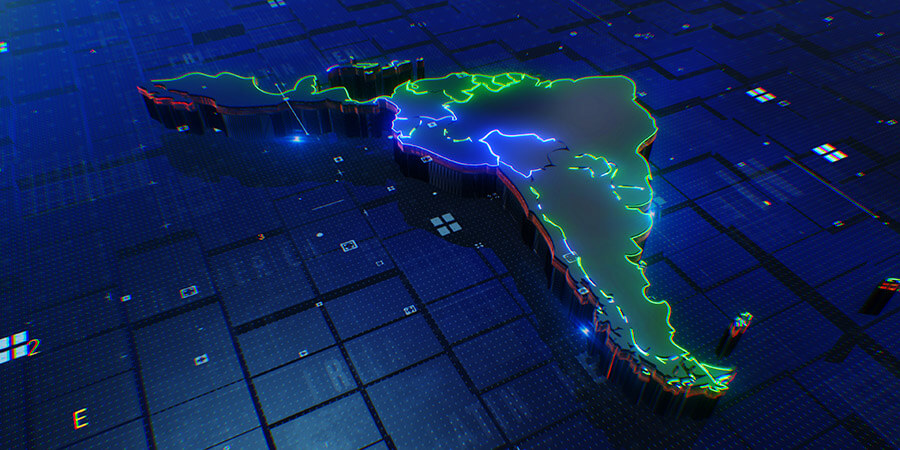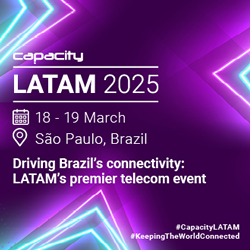Now is the time to accelerate each nation’s commitment and investments to innovation to drive economic growth. This is being evident in the Latin American region, with the aim to ensure widespread access to broadband and to support the adoption of next-generation digital infrastructure, among other contributions.
Strong terrestrial and subsea connectivity connecting South America across the rest of the world, as well as the localization of interconnection services, content, and applications offer advantageous opportunities for local businesses, enterprises, and the broader digital community.
Moreover, emerging technologies today, particularly generative AI, promise to enable a wide range of transformative products with broad economic impact. With the right combination of talent, innovative thinking, and technological tools, better results are anticipated across the Latin American region.
Let’s go into details on the digital and connectivity progress among the four largest economies in Latin America: Brazil, Mexico, Argentina, and Colombia.
Brazilian Market Outlook
With the 2024 G20 summit set for Rio de Janeiro, Brazil is poised to play a vital role in global technology. Led by the Luiz Inácio Lula da Silva administration, efforts will focus on shaping the first global AI framework, aligning with Brazil's new industrial policy. This plan involves a USD 60 billion investment in biotechnology, chip development, and bolstering national sovereignty systems, aiming for sustainability and innovation until 2033. “It is very important that we have an industrial policy again that is innovative and digital to cater to global demands," said the Brazilian President.
Moreover, Brazil's National Telecommunications Agency has made significant strides, achieving 52.66% coverage of 5G-SA mobile telephony by 2023, nearing the 57.67% target for 2027. Particularly noteworthy is the attainment of targets for 5G implementation in the capitals of all Brazilian states and the Federal District by the providers who secured the 5G auction, surpassing expectations and outpacing schedules across numerous municipalities. Network capacity reached 83.7%, close to the 87% target for 2027.
Market competition in fixed broadband remains robust, while stability in mobile telephony followed regulatory actions after Oi Móvel's sale. Furthermore, internet usage surged to 84.15%, approaching the goal of 95% by 2027. This progress highlights Brazil's increasing importance in global tech and its commitment to digital innovation.
According to the ITU, there has also been a surge in the proportion of internet users in Brazil, which reached 84.15% according to the ITU, marking significant progress towards the objective of encompassing 95% by 2027.
Mexican Market Outlook
Over the past three decades, Mexico's technological advancements have been significantly influenced by its strategic geographic position, standing out in the Latin American region due to widespread internet and mobile device usage.
The current administration under López Obrador prioritizes universal connectivity through the Internet para Todos program, spearheaded by CFE-Telecomunicaciones e Internet para Todos, a subsidiary of the Federal Electricity Commission (CFE). Launched in 2019, the program aims to extend internet access to rural and underserved communities, utilizing various technologies including wireless broadband, fiber optics, satellites, and mixed solutions.
Despite challenges posed by the COVID-19 pandemic and global supply chain disruptions, the deployment of Internet Para Todos has progressed. By the end of 2022, Mexico boasted 96.8 million internet users, with urban areas showing higher connectivity rates compared to rural regions.
Efforts to expand telecommunications infrastructure, including the planned auction of spectrum bands, face obstacles such as high annual rights payments. This pricing regime inhibits new market entrants and limits expansion opportunities for existing operators, as highlighted by the Federal Telecommunications Institute (IFT).
Despite these challenges, Mexico's telecommunications sector reports stable activity, driven by increasing demand for both fixed and mobile services. Fitch Ratings predicts relative stability in the mobile market, dominated by America Movil, but emphasizes the need for policy support to facilitate 5G deployment and infrastructure investments.
With over 100 million Mexicans now online and 123.5 million active cellular mobile connections as of early 2023, Mexico's digital landscape continues to evolve, albeit with ongoing challenges and opportunities for growth.
Argentinian Market Outlook
Argentina's tech sector is experiencing rapid growth, offering a range of opportunities from software development to IT outsourcing. With supportive policies, the country could see an annual economic impact of up to USD 149 billion by 2030. Buenos Aires, the capital, has emerged as a significant tech hub in Latin America, nurturing a dynamic startup ecosystem through accelerators and incubators.
The government has also been proactive in supporting the tech industry, implementing policies to foster entrepreneurship and attract investments. In telecommunications, Argentina has seen significant developments, including a recent 5G auction and deregulation efforts. With a stable market and ample spectrum allocation, Argentina is positioned for growth in mobile services.
Investments in the telecom sector focus on improving infrastructure, including expanding broadband access and enhancing network capabilities. While 5G deployment is a mid-term goal, the country is actively preparing its fiber-optic network and infrastructure for future advancements.
In the startup landscape, Argentina shines in deep tech, boasting over 100 leading companies valued at USD 1.9 billion collectively. The country also hosts a skilled IT workforce of over 130,000 software developers and engineers, contributing to its reputation as a regional leader in software engineering skills.
With approximately 68% of the population having internet access, Argentina is well-connected, though some regions still lack full 4G coverage. Preparations for 5G implementation are underway, promising faster connections and driving innovation, particularly in IoT and smart city developments. Major tech hubs include Buenos Aires, Cordoba, Mendoza, and Rosario, driving Argentina's position as a tech leader in the region.
Columbian Market Outlook
In February 2024, Colombia's Ministry of Information and Communication Technologies (MinTIC) and the National Planning Department (DNP) unveiled the government's National Digital Strategy (NDS) for 2023-2026. Simultaneously, ICT Minister Mauricio Lizcano signed resolutions permitting the winners—Claro, Wom, Movistar-Tigo Temporary Union, and Telecall—of the 5G auction to commence deploying networks across Colombia. Each operator secured an 80 MHz block in the 3,500 MHz band, earmarked for deploying the new connectivity technology. This is aligned to the ministry’s commitment to transforming Colombia into a Digital Power, prioritizing connectivity and technology to enhance lives.
The NDS outlines goals such as expanding mobile and fixed internet access, improving mobile accessibility, raising awareness of safe and responsible ICT usage, and providing digital skills training across society. With this in mind, Colombia is well-prepared for digital transformation, with the National Development Plan targeting universal internet access by 2026 and fostering a digital culture for mutual benefit.
Recognized as the "Silicon Valley of Latin America," Colombia has garnered significant investor interest. ICT plays a pivotal role in boosting the country's productivity and competitiveness, with substantial growth in the sector driven by initiatives like Plan Vive Digital (2010-2018). The influx of multinational companies has led to a surge in average salaries and digital nomads.
Looking ahead, Colombia boasts the most extensive fiber optic network in South America and aims to extend fiber optic broadband to 4 million homes and businesses by the end of 2023.
Expanding Digital Connectivity
The full potential of fostering growth and inclusivity throughout the region remains largely untapped. While Latin America and the Caribbean (LAC) have made significant strides in establishing the necessary hardware for digital communication—such as cables, towers, and interchanges—several critical challenges persist.
Firstly, remote areas still lack basic coverage, particularly in rural and peri-urban regions where private investment is limited due to low profitability. Secondly, there's a gap between the physical infrastructure in place and the actual access to broadband services, often due to cost barriers or lack of interest among potential users. Thirdly, investments in digital and traditional human capital skills, education, and regulatory frameworks are essential to maximize the benefits of broadband connectivity.
In the policy realm, innovations like free or low-cost connectivity access points in public spaces have been implemented in countries like the Bahamas, Bolivia, Colombia, Jamaica, and Peru. Shared infrastructure agreements, such as towersharing among service providers, not only reduce deployment costs but also foster competition and lower prices for consumers. Partnerships like "Internet para Todos" in Peru aim to bring connectivity to over 6 million rural residents, illustrating collaborative efforts to bridge the digital divide.
LAC has seen progress in expanding mobile internet coverage, with only a 7% coverage gap affecting around 45 million people. Satellite connectivity even offers a cost-effective solution for remote and challenging terrains. As an example, Argentina's plan to deploy a geostationary satellite, ARSAT-SG1, aims to connect over 200,000 rural households in Argentina and around 80,000 households in Bolivia, Chile, and Paraguay.
Closing Note
As per a 2023 World Bank report, Latin America has made considerable strides towards achieving near-universal basic digital coverage. However, the current challenge lies in attaining universal broadband access and usage, particularly in underserved market segments. To overcome this hurdle, a combination of innovative technological solutions, institutional mechanisms, and robust political and financial commitments are imperative.
Moreover, governments can perceive digital connectivity as an avenue for innovation, experimentation, and learning. By exploring new service delivery models in sectors like education, healthcare, agriculture, technology extension programs in manufacturing, entrepreneurship, and social assistance, opportunities for development and improvement can be identified and tested.









